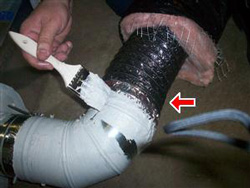Aug 01, 2022

A lot of homeowners forget about ductwork when considering the efficiency of their home’s HVAC system, even though leaky ducts can result in a lot of energy waste. If you’re wondering how to use duct sealant to help make your HVAC system more efficient, then get ready for us to spill all the secrets behind duct sealant putty and how to use it. We’re here to answer all your questions—from what is duct seal to how to use duct seal. We’ll teach you how to use duct seal putty to save energy and money while using your HVAC unit.
What is Duct Seal?
If you’re noticing that your HVAC system isn’t as efficient as it used to be—either because your electric bill is running high or your home doesn’t seem to cool or heat like normal—that could be due to leaks in your ductwork. Duct sealant is a great solution to this problem. Start by examining your home’s ductwork or hiring a professional to inspect it for leaks. An annual duct cleaning is a great way to locate small leaks before they become substantial. If you catch them before they get too big, they’re mendable. If they’re small enough, you may even be able to fix the issue yourself.
There are different types of duct seal, but duct seal putty is one of the best. Duct seal putty is sometimes likened to dough due to its soft consistency. It’s easy to handle and install for many HVAC purposes, but it’s mostly used to seal holes and leaks. Duct sealant putty is perfect for blocking out dust, moisture, noise, and air movement from holes in your ductwork. It’s best for sealing up small cracks and gaps and performs better than duct tape.
If you’re learning how to use duct seal putty to seal gaps in your ductwork, it’s best to use quality materials so don’t attempt to cut corners on the cheapest brands out there. Some silicone-based duct sealants can be applied using a mastic gun. Always wear gloves when handling duct sealant, and if you need to cover larger or complex areas, use it with a fabric mesh to make a flexible joint.
When and How to Use Duct Sealant
Leaky ducts are one of the most overlooked aspects of an HVAC system, even though an average home wastes between 20 and 30 percent of airflow due to leaks in the ducts. Now that you know what duct sealant is and that it can help make your HVAC system more efficient, it’s time to learn when and how to use duct seal properly
When to Use Duct Sealant
The unfortunate thing about leaky ductwork is that it’s barely noticeable and therefore difficult to detect. That doesn’t make them insignificant. Small leaks can add up to enormous efficiency losses, costing you a lot of money in the long run. Annual duct cleanings can help you locate leaks quickly and get them resolved. The best time to use duct sealant is as soon as you (or your HVAC technician) notice a leak.
How to Use Duct Sealant
Sealing the ductwork of your home is the simplest way to make them more efficient. Keep in mind that in most ducts, you aren’t dealing with a single big leak in one place but rather lots of small leaks throughout the system. When using duct seal putty to cover up holes and gaps, follow these simple steps for the most efficient fix:
- Locate the air duct leaks. Accomplish this step by turning on your HVAC system--either to heat or cool--and feel for any airflow coming from areas it shouldn’t flow. Listen for hissing noises to locate small leaks. Once you’ve located the leaks, turn off the HVAC system during the repair.
- Choose your duct sealant. There are several different types of duct sealants from putty to tapes. Determine which material will be best for the leaks you’ve discovered.
- Clean around the leak. Before you can apply the duct sealant, clean around the gap using a damp cloth. Remove any dust or other debris that might interfere with the application of the sealant.
- Apply the duct sealant. Once the area is clean, apply the duct tape or putty around the crack, covering the gap. Let the sealant dry for a full 30 minutes before using your HVAC system.
Call CroppMetcalfe for the Job
If you need help making your HVAC system more efficient, then our skilled team at CroppMetcalfe can get the job done. Reach out to us today to schedule a service visit.